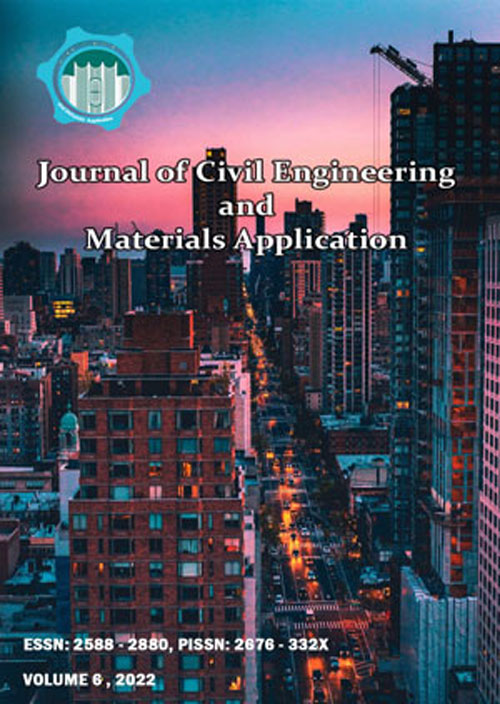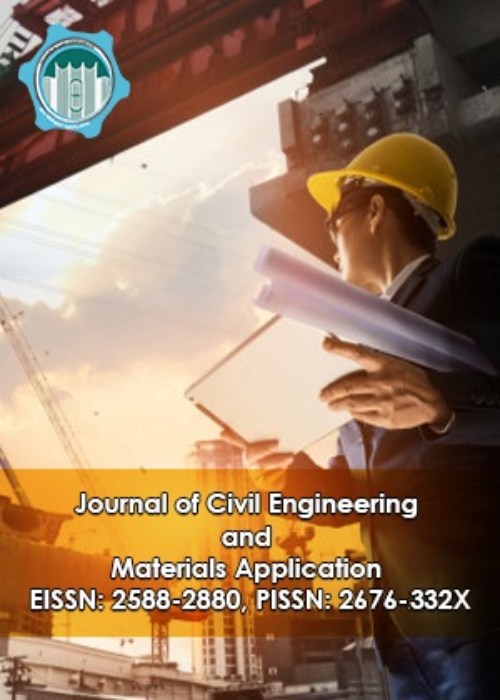فهرست مطالب

Journal of Civil Engineering and Materials Application
Volume:6 Issue: 2, Spring 2022
- تاریخ انتشار: 1401/05/19
- تعداد عناوین: 5
-
Pages 67-77
The main objective of this paper is to assess the feasibility of the application of activated charcoal (AC) that could be used as a component of mortar material for thermal insulation. To achieve the objective, several specimens were prepared by varying the content of AC in the mortar, and then the physical and mechanical properties of those specimens were tested. The result indicates a significant decrease in the compressive strength (13.33 MPa to 7.07 MPa at 28 days) with an increase in AC content [cement: AC - 1:2 (v/v) to 1:2.5 (v/v)] in the mortar. However, beyond a certain point [1:2.5 (v/v) to 1:4 (v/v)] the decrease in compressive strength is comparatively smaller (7.07 MPa to 4.71 MPa in 28 days). The thermal conductivity of cement-AC mortar is reduced by 54 - 71% compared to that of a mortar containing cement–sand. Overall, the study indicates that the incorporation of AC in the mortar has resulted in a significant reduction in thermal conductivity, with an acceptable range of compressive strength. The compressive strength of the mortar is within the permissible limit for a load-bearing structure having a cement to AC ratio up to 1:2.5. The composition having cement to AC ratio within 1:4 could be used as mortar for non-load bearing structure.
Keywords: Activated charcoal, Building material, Compressive strength, Thermal conductivity, Mortar -
Pages 79-86
Asphalt mixtures are composed of two components, namely aggregate and bitumen, so that many structural weaknesses of an asphalt mixture can be resolved by modifying these components. In the past, various research works have been done to improve these weaknesses using a versatile spectrum of different materials. Among others, recycled materials have attracted more attention thanks to their further environmental benefits. On this basis, in the present work, steel slag and recycled polyethylene were used with different compositions at different percent dosages. In order to evaluate the effects of these two materials, we used resilience modulus test, Marshall Resistance test, dry and wet indirect traction tests, and moisture sensitivity test. Results showed that incorporation of both materials in a mixture provides for a better output than the use of either of them alone. Indeed, the blending of these two materials helps address the weaknesses of either of them.
Keywords: steel slag, Recycled polyethylene, Asphalt Mixture, Performance characteristics -
Pages 87-98
In recent decades following a lot of droughts many changes have been made in the quantity and quality of the country water resources. This factor has caused many uncertainties in the management of the country water resources. The purpose of this study is to improve the understanding of drought effects on the quantity and quality of water resources in Lorestan province during the years 2008 to 2018 by coherence and cross wavelet method. To achieve this goal, first to drought assessment according to precipitation data has been examined using (SPI) index and then the effect of drought on Khorram river runoff is analyzed. Then, the global index of water and the drought impact on this index in the Khorram River were evaluated. Also the global index of water quality (WQI) and the impact of drought on this index in the Khorram River are evaluated. The results of coherence and cross wavelet indicated the relative effect of precipitation with a wavelet coherence coefficient of 0.6 on changes in water runoff in the Khorram River is of degree first importance. Also, the relative impact of drought with a wavelet coherence coefficient of 0.4 changes in water quality of Khorram River has been more than other factors. Therefore, climatic factors in reducing the water runoff of Khorram River from factors other are more important. Also, the results showed human factors as the most important one in water quality changes of Khorramabad River.
Keywords: Index SPI, Drought, Khorram River, WQI Index, Coherence Wavelet -
Pages 99-111
Common methods of controlling setting, hardness, process of strength concrete are tests for determining the setting time of mortar and concrete and determining the compressive strength of concrete It seems that these physical methods, do not fully reflect the behavior of concrete and the process of changing phase states during the hydration process; however, with the method of the electrical resistance of concrete, this observation is possible. Therefore, in this study, at the first stage, 11 samples of cement were prepared, the phases of which varied, but due to laboratory cementation, their fineness and grading conditions were almost the same. Physical and chemical analysis of cement samples was performed. In the next step, 22 concrete mixtures with 11 cement samples were prepared, so that 11 mixtures without additives and 11 mixtures with constant dosage of commercial super plasticizer. Also in the all concrete mixtures, the slump kept constant about 8 cm. Compressive strength tests of 7, 28 and 90 days hardened concrete were performed on concrete mixtures. Also, an electrical resistance test was performed, which was performed regularly from the time of cement contact with water until 31 days later. The results showed that at least three peaks of 8, 16 and 23 days in the electrical resistance curve are seen along the test time. In almost all samples, the electrical resistance is reduced to about 3 hours, which indicates the setting time of the concrete. Based on the results of this study, formula was presented.
Keywords: Electrical resistance, cement, Concrete, additives -
Pages 113-122
This paper describes the behavior of soft soil foundation under Surcharge and with and Without prefabricated vertical drains (PVDs) or Vacuum Preloading base on a trial embankment which was built in Bangkok International Airport, Thailand. An analytical solution considering the variation of soil permeability and compressibility was adopted. Three scenarios were modeled and analyzed for Bangkok airport as: Model A: Application of surcharge load alone (i.e., no vacuum and PVD installation), Model B: Application of surcharge load combined with PVD (i.e., no vacuum application), Model C: Application of surcharge load combined with PVD and 60 kpa constant vacuum preloading and Model D: Application of surcharge load combined with PVD and field vacuum that was applied on site. The associated settlements at the embankment centerline are predicted and compared with the available field measurement. The field data show that the efficiency of this soil treatment technique depends on the magnitude and distribution of vacuum pressure. The height of surcharge and consolidation time can be significantly reduced in comparison with the conventional method of surcharge alone or surcharge and pvd alone. The findings of this study are expected to be useful to design engineers involved in the construction of embankments on weak grounds.
Keywords: surcharge, Soil treatment, vacuum consolidation, PVD


